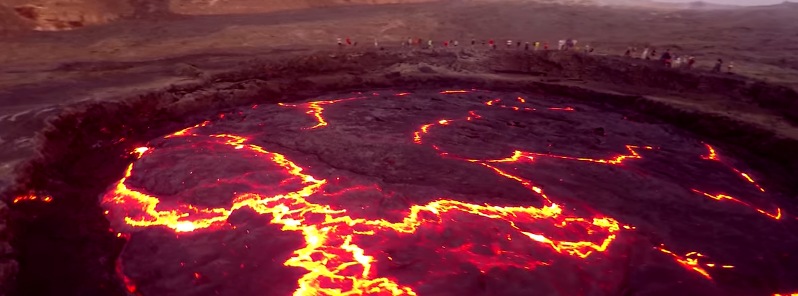Erta Ale’s lava lake close to overflowing, Ethiopia

The active lava lake in the southern pit of the Ethiopian Erta Ale volcano, 30 – 40 m (100 – 130 feet) in diameter, remains very active and approaches levels close to overflowing the margins of the pit again, being only a few meters below the floor of the caldera, Volcano Discovery reports.
Erta Ale, known in the local Afar language as the "smoking mountain" and "the gateway to hell" is a continuously active basaltic shield volcano in the Afar Region of northeastern Ethiopia. It is centered over the East African Rift system, a triple junction setting whose movements are resulting in the formation of a pull-apart basin or rift. The volcano comprises mainly Mafic material (silicate mineral or rock rich in magnesium and iron) which has been brought up to the surface caused by unroofing of the mantle due to this rift formation.
Not much is known about Erta Ale, as the surrounding terrain is some of the most inhospitable on Earth and the native Afar people have a legendary reputation for viciousness towards outsiders. Nevertheless, a Volcano Discovery group is currently there and we expect fresh news in about 10 days.
Erta Ale experienced a major eruption on September 25, 2005 which killed 250 head of livestock and forced thousands of nearby residents to flee. There was further lava flow in August 2007, forcing the evacuation of hundreds and leaving two missing.
Scientists from the Afar Consortium Project observed the lava lake during November 21 – 23, 2010 and noted Strombolian activity. The lava lake had filled the pit crater and breached the west rim, spilling two lava flows into the main crater. The lava lake was encompassed by a scoria ring that was about 4 m (13 feet) high on the south side. By November 23, the lake was above the scientist's eye level when they stood west of the southern pit in the main crater.
To have a better understanding of Erta Ale and the region it is situated in, we invite you to watch the video titled "Ethiopia from the air", filmed and edited by Boris Pustovoytov and Evgeniy Selezenyov mid-November 2015.

Video courtesy of Boris Pustovoytov and Evgeniy Selezenyov
Geological summary
Erta Ale is an isolated basaltic shield volcano that is the most active volcano in Ethiopia. The broad, 50-km-wide edifice rises more than 600 m from below sea level in the barren Danakil depression. Erta Ale is the namesake and most prominent feature of the Erta Ale Range. The 613-m-high volcano contains a 0.7 x 1.6 km, elliptical summit crater housing steep-sided pit craters. Another larger 1.8 x 3.1 km wide depression elongated parallel to the trend of the Erta Ale range is located to the SE of the summit and is bounded by curvilinear fault scarps on the SE side.
Fresh-looking basaltic lava flows from these fissures have poured into the caldera and locally overflowed its rim. The summit caldera is renowned for one, or sometimes two long-term lava lakes that have been active since at least 1967, or possibly since 1906. Recent fissure eruptions have occurred on the northern flank. (GVP)
Featured image credit: Boris Pustovoytov and Evgeniy Selezenyov – November 2015.

Commenting rules and guidelines
We value the thoughts and opinions of our readers and welcome healthy discussions on our website. In order to maintain a respectful and positive community, we ask that all commenters follow these rules:
We reserve the right to remove any comments that violate these rules. By commenting on our website, you agree to abide by these guidelines. Thank you for helping to create a positive and welcoming environment for all.